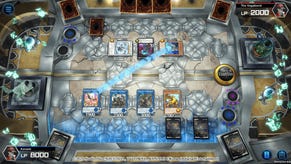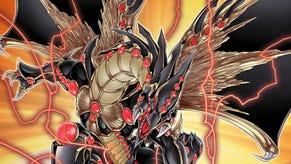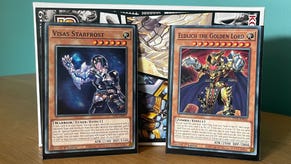The 10 best Yu-Gi-Oh! cards, from legendary icons to game-changing powerhouses
Precious duels.
In over 20 years as one of the most recognisable card games operating today, Yu-Gi-Oh! has amassed an impressive range of powerful and iconic cards. From its original booster packs to the latest modern-day sets, the best Yu-Gi-Oh! cards are those monsters, spells and traps that went on to define how the game was played, transforming the TCG for years to come.
Best Yu-Gi-Oh! cards
- Dark Magician
- Blue-Eyes White Dragon
- Exodia The Forbidden One
- Pot of Greed
- Yata-Garasu
- Cyber Dragon
- Crush Card Virus
- Maxx “C”
- Legendary Six Samurai - Shi-En
- Performapal Monkeyboard
There are plenty of Yu-Gi-Oh! cards that fit this bill from throughout the history of this iconic franchise. Here are just a few of the most iconic monsters, spells and traps from this most auspicious of trading card games.
1. Dark Magician
A magical introduction
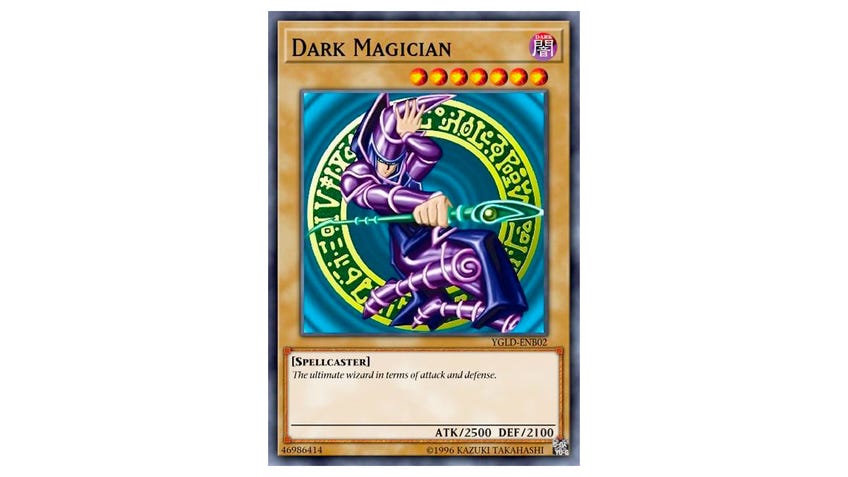
Where else could we start a list of the best Yu-Gi-Oh! cards than with a mention of Yugi Muto’s iconic boss monster? When people think of Yu-Gi-Oh!, they think of Dark Magician - and in the early days of the card game before Synchro or Link monsters, a game-winning strategy could be as simple as copying your favourite anime character.
While maybe not as powerful today as it once was, for fans who grew up on the original TV series and remember Yugi winning with his Dark Magician, some players still wish to feel the same rush that comes from taking their favourite card to victory. Its popularity resulted in an array of support cards, such as Magician Navigation, being created in order to make it easier for fans to use this iconic card.
Dark Magician may not be the most competitive card in Yu-Gi-Oh! today, but it’s a showcase of how the popularity of a single card can allow it to persevere as a viable strategy in duels for over 20 years.
2. Blue-Eyes White Dragon
A card that soars

It would be impossible to mention Dark Magician in a list of Yu-Gi-Oh!’s most iconic cards without mentioning the boss monster of Yugi’s rival, Seto Kaiba. Like Dark Magician, an entire archetype has spawned around it with the express purpose of making this 3000 ATK boss monster easier to summon, with monsters such as The White Stone of Legend being made just to make this monster easier to search and summon to the field.
Beyond this, however, Blue-Eyes White Dragon can boast its status as one of the most valuable Yu-Gi-Oh! cards released to date. As the rarest card to pull in the original Legend of Blue-Eyes White Dragon booster pack, a first-edition copy can sell at auction for thousands of dollars.
Even away from its monetary value, Blue-Eyes White Dragon is still an intimidating beast to face in a duel. Perhaps it’s no surprise that, just like in the TV show, top duels in the game’s infancy often recreated the Dark Magician vs Blue-Eyes match-up.
3. Exodia The Forbidden One
Win on your terms
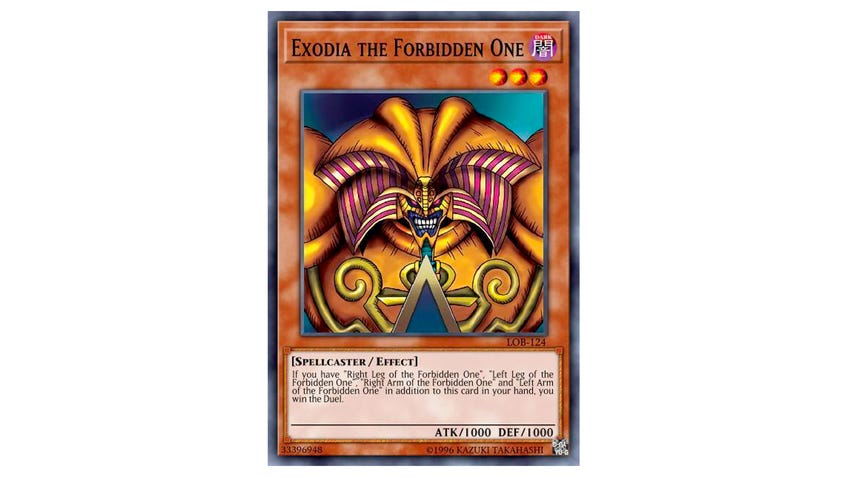
One of the first Yu-Gi-Oh! cards to introduce alternative win conditions to the TCG, Exodia The Forbidden One allows players to instantly win the duel provided they draw all five pieces of Exodia. With such a unique win condition, players immediately tried to put together decks that would give them the highest chance of drawing these pieces as quickly as possible.
In the years since this card’s release, several similar monsters - such as Victory Dragon - have introduced new mechanics that allow players to win through means other than taking your opponent’s life points to zero. Despite this, none are quite as memorable or satisfying as Exodia, which remains one of the few Yu-Gi-Oh! cards with a unique win condition not to be banned from competitive play. Its legacy continues as players find new and inventive ways of cycling through their decks, all to recreate the satisfaction that comes from drawing all five pieces.
4. Pot of Greed
“Draw 2 cards.”

The three-word effect of Pot of Greed may appear naively simple at first, but it’s this simplicity that makes it one of the most powerful and iconic banned Yu-Gi-Oh! cards in the game today. At a time when the TCG was far slower than it is today, Pot of Greed was one of the few cards that any deck could play that would instantly provide access to new cards from your deck with zero cost.
The card’s utility and ability to be used in any deck eventually led to it being banned for offering an unfair advantage. In subsequent years, an entire array of ‘Pot’ cards like Pot of Avarice or Pot of Prosperity have been created in an attempt to offer similar, fairer spins on this powerful spell card. Yet while these various Pot spell and trap cards allow players to draw just like the original, each comes with a cost. It’s unlikely we’ll ever get a cost-free draw card like this ever again.
5. Yata-Garasu
A bird forced into extinction

It may not seem like much, but we have Yata-Garasu to thank for the introduction of the Yu-Gi-Oh! banlist. Who would have thought a mere bird with just 300 ATK would interrupt the game to the extent that the game makers had little choice but to ban the card from competitive play?
Yata-Garasu was the key card in the Yata Lock deck that dominated early Yu-Gi-Oh! By clearing your opponent’s field and hand before summoning and attacking with Yata-Garasu, it was possible to prevent your opponent from playing the game. Yata-Garasu’s effect to force your opponent to skip their Draw Phase if they took damage from this bird caused many players to build decks with the express purpose of preventing your opponent from playing their deck. It was so disruptive to play that the first forbidden list was introduced soon after in 2004, banning the card - where it stays to this day.
6. Cyber Dragon
One form of revolution

Cyber Dragon, alongside being a fan-favourite card from the GX anime, is known for how it transformed how Yu-Gi-Oh! was played following its release in Cybernetic Revolution. At the time, Special Summons were far rarer and the game was much slower, so the idea of summoning a monster with over 2000 ATK on your opening turn was much harder.
The game transformed around Cyber Dragon as a result, with decks featuring the card taking first place at the Yu-Gi-Oh! World Championships for three years in a row. Even today, with the continued support for the card with new Link and Xyz support, alongside its ability to Special Summon itself if only your opponent controls a monster, the card remains relevant in select rogue decks in the modern meta, over 15 years on from its release.
7. Crush Card Virus
Crushing player dreams

Crush Card Virus represents the extremes of what can happen when the most powerful cards in Yu-Gi-Oh! are also the most difficult to get. This trap card first hit the competitive scene as a prize card only available to the lucky few to win an officially-sanctioned tournament event, with fewer than 50 being offered to an exclusive selection of players who placed highly in official tournaments in the first half of 2007.
The effect of Crush Card Virus effectively capped the potential of your opponent to play the game by allowing you to check their hand and draws for the next three turns, destroying any monster with over 1500 ATK. If hit by this card’s effect, most decks could only hope to stall their opponent until its effect wore off. So strong was this card that, despite its rarity, the majority of top decks in major tournaments at this time played at least one copy. Banned not long after an official reprint opened the card to the masses, only an errata could bring the card off the ban list. Today, it remains one of the most powerful prize cards in TCG history.
8. Maxx “C”
Take the cockroach challenge
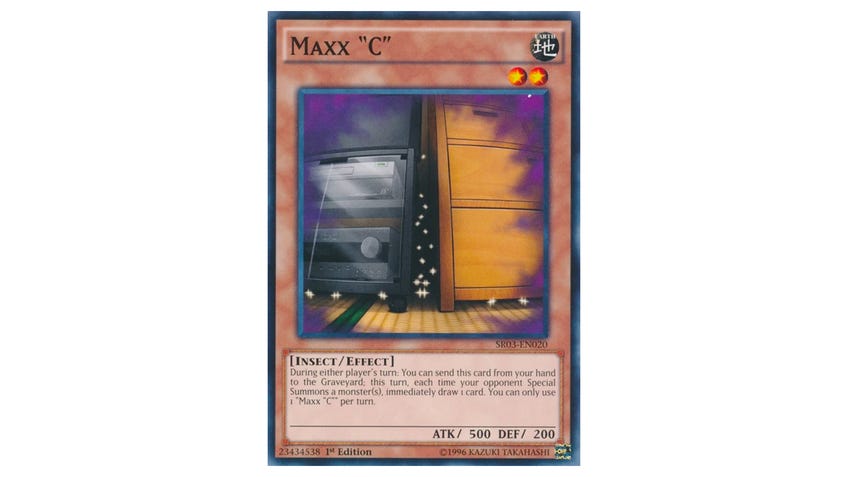
A cockroach with the potential to change the tide of a duel, Maxx “C” introduces a puzzling conundrum for any opponent to overcome upon its activation. This hand trap can be discarded at any time during either player’s turn, allowing the user to draw one card every time their opponent Special Summons a monster.
Thus, the Maxx “C” Challenge was born. Do you hold back and end your turn to prevent your opponent from drawing more cards? Or do you persevere, understanding that your opponent could draw the perfect counter or tool for their next turn at any time? Some decks took this a step further, summoning endlessly in a loop that would force the activating party to deck out and lose. The added tension that comes from this card ensures it remains a beloved favourite among Yu-Gi-Oh! fans, despite being banned in the TCG.
9. Legendary Six Samurai - Shi-En
A true legend

In its prime, the use of Gateway of the Six and monster effects allowed the Six Samurai deck to flood the board with monsters in an intimidating display of strength. To turn that strength into a game-winning board, however, you needed Legendary Six Samurai - Shi-En.
It was simple for Six Samurai decks to summon this Synchro monster thanks to the ease at which it could get the necessary materials onto the field, and was often crucial in preventing your opponent from putting a stop to your strategies. Shi-En offered the deck a method to negate any spell/trap card that might disrupt play, and only became more powerful in conjunction with Great Shogun Shien, limiting your opponent to one spell or trap card per turn. The negation abilities of Shi-En helped the deck become one of the most dominant decks in Yu-Gi-Oh! history, and is remembered fondly enough to ensure support for the archetype continues to this day.
10. Performapal Monkeyboard
Looks can be deceiving
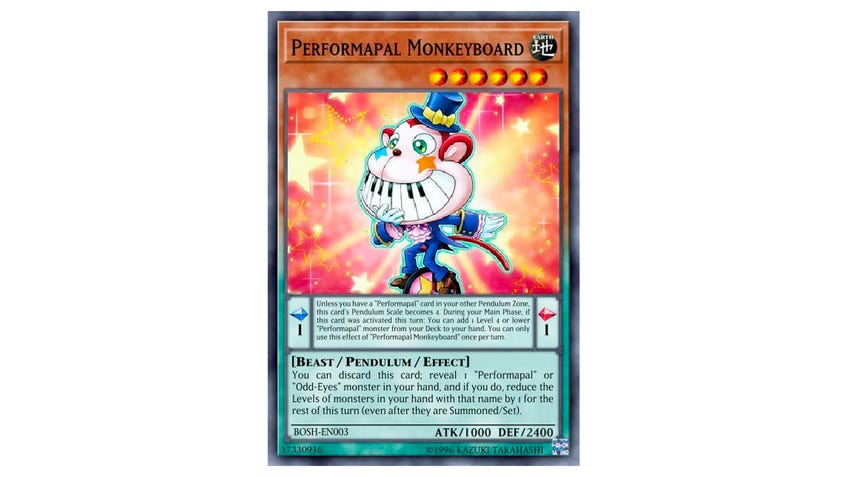
This smiling monkey may not look like much, but Performapal Monkeyboard is one of the best Yu-Gi-Oh! cards in the modern era thanks to its central role in one of the most powerful decks ever to brace the TCG: the PePe deck. Short for the two archetypes that drove the deck, Performapal and Performage, Monkeyboard could create a Pendulum Scale with ease thanks to its search effect, turning a single card into an outlet to initiate a Pendulum Summon and bring out terrifying Xyz monsters like Cyber Dragon Infinity and Tellarknight Ptolemaeus.
With over 90% of decks topping some tournaments being PePe and running three copies of Performapal Monkeyboard, the strength of this card was impossible to ignore. In a rare move by Konami, this card resulted in an emergency banlist that banned this and other key cards from competitive play. As with many of the cards on the list, the game of Yu-Gi-Oh! was never the same following its release, and this seemingly-innocent looking monkey remains banned in competitive play, unlikely to return.







